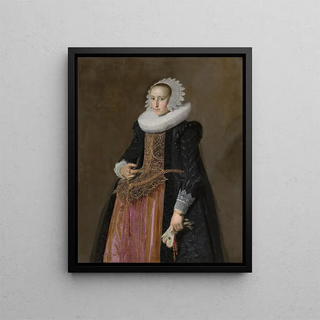Art print | Portrait of Aletta Hanemans - Frans Hals


View from behind

Frame (optional)
Portrait of Aletta Hanemans - Frans Hals – Captivating Introduction
The "Portrait of Aletta Hanemans" by Frans Hals is an iconic 17th-century artwork that embodies both the artist's technical virtuosity and the timeless beauty of his model. This painting, depicting a young woman of rare elegance, immerses us in the world of Dutch portraiture where light and shadow engage in a captivating ballet. Aletta Hanemans, wife of a wealthy merchant, is portrayed with a delicacy that transcends mere pictorial rendering. The vibrant colors and meticulous details of her dress, along with the gentle expression on her face, testify to an exceptional craftsmanship. By contemplating this work, the viewer is invited to discover not only the beauty of the model but also the story behind this fascinating portrait.
Style and uniqueness of the work
Frans Hals's style is distinguished by his ability to capture spontaneity and life in his portraits. Unlike other masters of his time, Hals favors a free and dynamic brushwork, creating an impression of movement and spontaneity. In the "Portrait of Aletta Hanemans," this approach is evident in the fluidity of the drapery and the vividness of the colors. The light, omnipresent, sculpts the forms and accentuates Aletta's facial features, giving her an almost living aura. The gaze of the young woman, both direct and mysterious, engages the viewer in a silent conversation, making the work even more captivating. This stylistic singularity, combined with a balanced composition, makes this portrait a key piece in Hals's repertoire and a shining example of Baroque portraiture.
The artist and his influence
Frans Hals, born in Antwerp in 1582, is one of the most illustrious representatives of the Dutch Golden Age. His career, spanning several decades, is marked by a constant exploration of pictorial techniques and human emotions. Hals managed to establish himself in a competitive artistic environment by developing a style that combines realism and expressiveness. His innovative approach influenced many artists, both contemporaries and successors, who

Matte finish

View from behind

Frame (optional)
Portrait of Aletta Hanemans - Frans Hals – Captivating Introduction
The "Portrait of Aletta Hanemans" by Frans Hals is an iconic 17th-century artwork that embodies both the artist's technical virtuosity and the timeless beauty of his model. This painting, depicting a young woman of rare elegance, immerses us in the world of Dutch portraiture where light and shadow engage in a captivating ballet. Aletta Hanemans, wife of a wealthy merchant, is portrayed with a delicacy that transcends mere pictorial rendering. The vibrant colors and meticulous details of her dress, along with the gentle expression on her face, testify to an exceptional craftsmanship. By contemplating this work, the viewer is invited to discover not only the beauty of the model but also the story behind this fascinating portrait.
Style and uniqueness of the work
Frans Hals's style is distinguished by his ability to capture spontaneity and life in his portraits. Unlike other masters of his time, Hals favors a free and dynamic brushwork, creating an impression of movement and spontaneity. In the "Portrait of Aletta Hanemans," this approach is evident in the fluidity of the drapery and the vividness of the colors. The light, omnipresent, sculpts the forms and accentuates Aletta's facial features, giving her an almost living aura. The gaze of the young woman, both direct and mysterious, engages the viewer in a silent conversation, making the work even more captivating. This stylistic singularity, combined with a balanced composition, makes this portrait a key piece in Hals's repertoire and a shining example of Baroque portraiture.
The artist and his influence
Frans Hals, born in Antwerp in 1582, is one of the most illustrious representatives of the Dutch Golden Age. His career, spanning several decades, is marked by a constant exploration of pictorial techniques and human emotions. Hals managed to establish himself in a competitive artistic environment by developing a style that combines realism and expressiveness. His innovative approach influenced many artists, both contemporaries and successors, who






